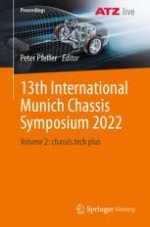2024 | OriginalPaper | Buchkapitel
Virtual Vehicle Development Approach to Optimize Energy Efficiency and Vehicle Stability of Electrified Vehicles Using Brake Blending
verfasst von : Dr.-Ing. Steven Yan, Ole Behnke, M.Sc., Dr.-Ing. Alexander Ahlert
Erschienen in: 13th International Munich Chassis Symposium 2022
Verlag: Springer Berlin Heidelberg
Aktivieren Sie unsere intelligente Suche, um passende Fachinhalte oder Patente zu finden.
Wählen Sie Textabschnitte aus um mit Künstlicher Intelligenz passenden Patente zu finden. powered by
Markieren Sie Textabschnitte, um KI-gestützt weitere passende Inhalte zu finden. powered by
